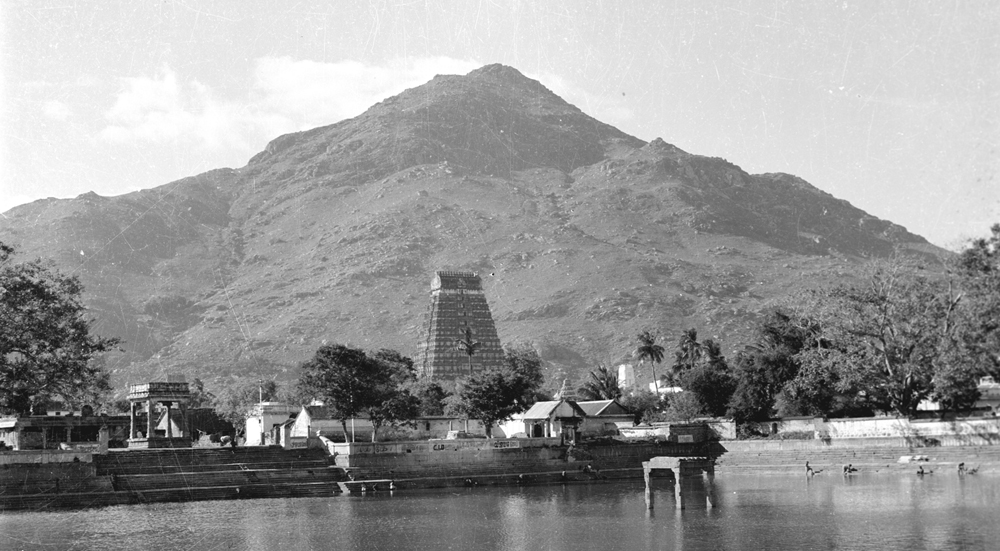Manikkavachagar’s visit to Tiruvannamalai

Manikkavachagar had been specially commissioned by Siva to tour the Tamil region and sing songs in His praise. One of the places he visited was Tiruvannamalai, which even then (in the 9th century) was a major Saiva pilgrimage centre. The Tiruvadavuradigal Puranam, a colourful and poetic retelling of Manikkavachagar’s life, includes the following verses that describe his visit:
After worshipping at that shrine [Tiru-Venney-Nallur],
with love in his heart he departed,
following the righteous path,
passing through the middle lands,
traversing tall forests and mountains,
where lions and fearsome elephants dwelt,
until he drew near to enduring Arunai’s city [Tiruvannamalai].
When he saw the palaces and gopurams,
the strong walls, decorated with jewels and pearls,
the great gateways festooned with banners,
towering up in the midst
of a cool densely wooded grove,
in a forest of tall areca trees,
he joyfully made obeisance,
experiencing great bliss.‘You [Siva] who abide in the form of a mountain
which appeared on that day as a column of flame
for the two to seek!
Blissful life which fills our hearts!’
Thus did he worship the Supreme Mountain Lord,
receiving His grace, before proceeding forth
to enter Arunai’s prosperous city.Leaving behind the groves, the city walls,
the streets decorated with many beautiful banners,
and the various shrines of the gods,
and taking the path which led to the holy presence,
he bowed down before the temple of the One
who wears in His locks a kondrai garland,
datura flowers, the moon and the snake,
and then did he perceive the form of Him
who on that day had enslaved him.
This line has been taken by some people to mean that Manikkavachagar had a vision of Siva in the Arunachaleswara Temple. T. M. P. Mahadevan in his Ten Saints of India (1971 ed., p. 55) has followed this interpretation. The story continues:
‘Praise be to the dark-throated One
who swallowed the poison halahala
when Brahma, Vishnu and the rest of the gods,
crying out in distress, appealed to Him for protection!
Praise be to the Mountain of cool ambrosia,
mixed with the milk of green-hued Unnamulai,
which men and gods alike drink down
to cure the overpowering malady of their birth and death!
Unnamulai is the local name of Siva’s consort in Tiruvannamalai.
‘Praise be to the great ocean of grace of Him
who placed His feet upon my head,
the feet which tall Mal could not see,
though he burrowed deep into the earth
in the form of a powerful boar!
Praise be to the Mountain of burnished gold,
at whose side sits the slender
green-hued form of Unnamulai,
who is the earth’s protectress!
In the traditional puranic story of the origin of Arunachala, Vishnu (Mal) took the form of a boar and burrowed into the earth in an unsuccessful attempt to find the lowest point of a column of light that Siva had manifested as.
‘Praise be to Him who granted His grace
to the victorious Durga,
when She worshipped Him and begged Him
to absolve Her from the sin
of killing the powerful buffalo-headed demon!
Praise be to the beauteous Lord Annamalai,
who came to me on that day and held me in His sway!’
Thus worshipping and praising the Lord
out of heart-felt love,
he dwelt there for some days.
The story of Durga killing the buffalo-headed demon Mahishasura appears in the Arunachala Mahatmyam, the Sanskrit text that chronicles the divine stories associated with Arunachala.
It was the month of Margazhi,
when, in the ten days before the ardra asterism,
the beautiful maidens go from household to noble household
calling each other out in the early dawn,
just as the darkness is dispersing,
and, banding together, go to bathe in the holy tank.
The month of Margazhi runs from mid-December to mid-January in the western calendar. In the Hindu calendar there is a cycle of twenty-seven days each month. Each day is named after a particular star. Ardra is one of these star days.
On observing their noble qualities
he sang the immortal hymn ‘Tiruvembavai’
which is composed as if sung by the maidens themselves.
Later, seeing them dance and sing
as they played the pretty game ‘Ammanai’,
he composed the song ‘Ammanai’ in the same manner. (From Tiruvadavuradigal Puranam, ‘Tiruvambala Sarukkam’, vv. 376-384, by Katavulmamunivar)

As the final verse in this sequence indicates, Manikkavachagar composed two of the Tiruvachakam poems, ‘Tiruvembavai’ and ‘Ammanai’, on his visit to Tiruvannamalai. There is a tradition in Tiruvannamalai that both poems were composed while Manikkavachagar was doing pradakshina of Arunachala. A small temple on the pradakshina road in the village of Adi-annamalai is supposed to mark the spot where the two poems were composed and sung. Bhagavan confirmed the validity of this tradition when he told Suri Nagamma: ‘He [Manikkavachagar] then stood at that particular place and addressing Arunagiri [Arunachala] sang the songs “Tiruvembavai” and “Ammanai”. (Letters from and Recollections of Sri Ramanasramam, by Suri Nagamma, 1992 ed., p. 2)
There is a festival in winter in which devotees go to their Siva temple very early in the morning to sing songs to Siva in order to wake him up. In ‘Tiruvembavai’ young girls move from house to house, waking up their friends, and encouraging them to come to the temple to perform this rite. Though, ostensibly, it is merely a poem about young girls encouraging each other to go and worship Siva, their trips to the temple are interpreted to be emblematic of the soul’s journey towards union with Siva. It is thus a poem which encourages enthusiasm for the ultimate pilgrimage that culminates in the experience of Siva. There are also more fanciful interpretations that see in its lines various allegories for the Saiva view on how the world is brought into being.